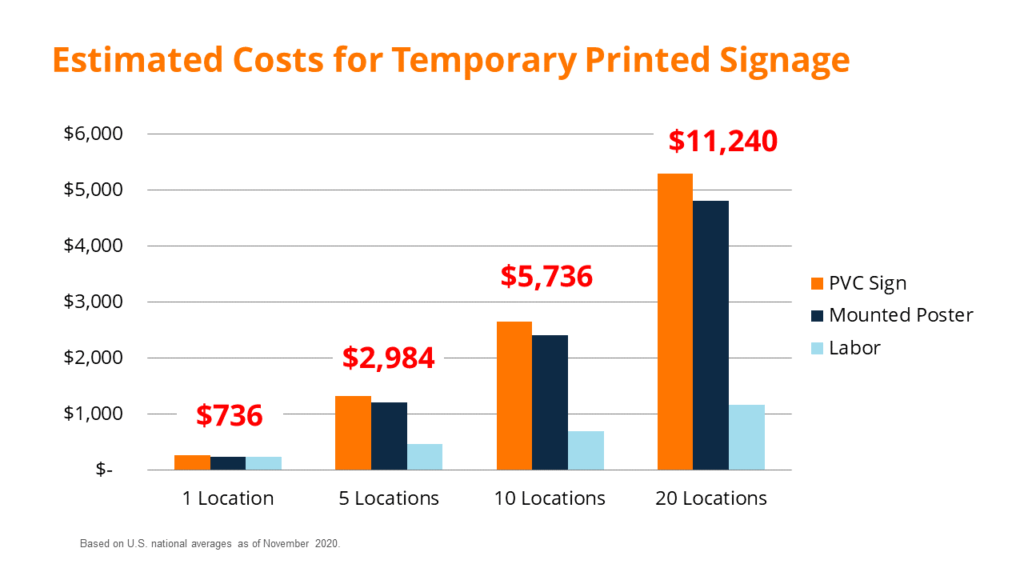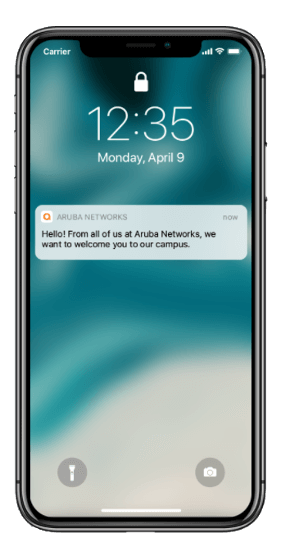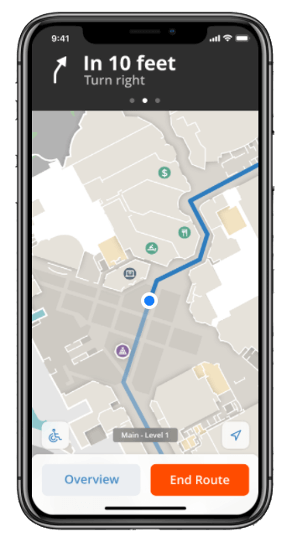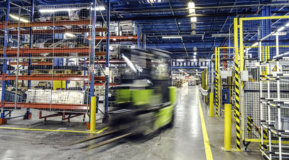Temporary directional signage is everywhere nowadays. From promotion of seasonal shop sales to pointers to flu shot locations, organizations gravitate toward these signs as an economical way to help constituents reach their destination. But is temporary directional signage as economical as it seems?
Consider the flu shot clinic scenario. Many healthcare systems hold annual flu shot clinics across their clinic and hospital sites. Signage is placed at each flu shot clinic site to guide patients to the flu shot distribution location. Facilities and marketing groups often plan to save and reuse the signage the following year. However, when it’s time for the next flu shot clinic, the signage often ends up misplaced, damaged, or out of date. That means the healthcare system must reprint signage.
Temporary signage costs aren’t trivial
While local printing costs may vary, national on-demand printing chain FedEx charges $59.99 for a 24” x 36” mounted poster, the type commonly placed on lightweight easels near building entrances and elevators. FedEx also charges $132 for a durable 36” x 48” PVC sign, which may be placed outdoors to promote the flu shot clinic and guide patients inside.
All that printing adds up. Assuming each site places 2 PVC signs at outdoor entrances, for example, and 4 posters at junction points inside the building, the healthcare system could incur over $500 in printing costs alone for each site. Healthcare systems often have multiple sites, so printing costs for a healthcare system with 20 flu shot clinic sites could spend over $10,000 in printing costs to support wayfinding alone for annual flu shot clinics.
Poster printing and wayfinding is about more than printing costs alone—it’s also about labor costs. For example, a marketing associate may be involved in managing a temporary signage project. Assume a marketing associate spends 40 hours of time managing this project. At the national average hourly wage for a marketing associate ($29 per hour), this project would cost the healthcare system $1,160 in labor costs, with labor costs likely increasing as more and more clinics come onboard.

Signage printing and labor costs increase as the number of locations with temporary printed signage grows.
And none of these estimates include the time administrative employees and frontline staff will spend answering the same patient questions repeatedly because patients on their phones tend to ignore physical signs.
Digital solutions for an analog problem
Digital campaign push notifications, coupled with digital wayfinding, can help organizations avoid the costs associated with temporary signage—as well as deliver a better patient experience. Here’s how.
First, push notifications greet the patient as they near the flu shot location. Aruba Beacons are placed at strategic locations within each flu clinic location site, such as near entrances and junction points. When a patient enters the range of an Aruba Beacon, a text notification can be pushed to their phone through a Meridian-powered mobile app: “Welcome! The flu clinic is on the second floor. Want to reserve your spot now?”

A context-aware push notification like this one can be delivered directly to a patient’s device as they near the clinic entrance.
After making their reservation in app, the patient then receives GPS-style turn-by-turn directions to the location where flu shots are being administered—no need to ask for directions. That’s because Aruba Beacons deliver accurate, tailored, immediate wayfinding guidance right to the device already in the palm of the patient’s hands.

BluDot wayfinding helps patients get to their destination without staff member assistance.
Digital push notifications and wayfinding vs. temporary printed signage
This digital approach provides several benefits over printed signage.
- Reduces printing costs. Updated signage no longer needs to be printed each year. Instead, the digital campaign message can be easily updated for each annual event.
- Helps organizations adapt quickly. If the location of the event changes, the digital campaign message can be quickly updated and immediately pushed.
- Avoids unnecessary maintenance burden. Fewer goods to store and track eases pressure on facilities teams. In addition, there are no additional physical items to clean and sanitize.
- Improves user experience. Mobile devices are ubiquitous, and many users appreciate the tailored and friction-free experience of an electronic alert delivered directly to them.
Mobile engagement and wayfinding: Not just for healthcare
Other kinds of organizations can use this model to avoid regular promotional and directional signage printing costs for events like:
- Annual retail sales. Retailers often hold major annual events like Black Friday or Customer Appreciation sales. Instead of reprinting signage each year with updated dates or creative designs, retailers can use Aruba Beacons and Meridian-powered apps to push promotional and wayfinding notifications to nearby shoppers.
- New student orientations. Every Fall brings a new group of students looking to complete administrative tasks and familiarize themselves with the campus before the start of classes. Aruba Beacons and Meridian-powered apps can push notifications directly to students’ devices, delivering a friction-free and (potentially) personalized way to welcome and guide them on their way.
- Onsite conference wayfinding. Hotels and conference centers host a variety of groups and conferences with groups and locations that change daily. While these establishments may not engage a professional print service for signage each day, there is usually a staff member responsible for updating, desktop printing, and posting wayfinding signs. Digital campaign notifications enabled by Aruba Beacons can eliminate much of this manual processing and result in a better experience for attendees.
Replacing manual, analog processes with digital communications: just one way organizations can leverage the Edge for improving efficiencies and enhancing customer experiences. Want to see more examples? Check out how Aruba ESP is helping organizations drive Edge transformation.




